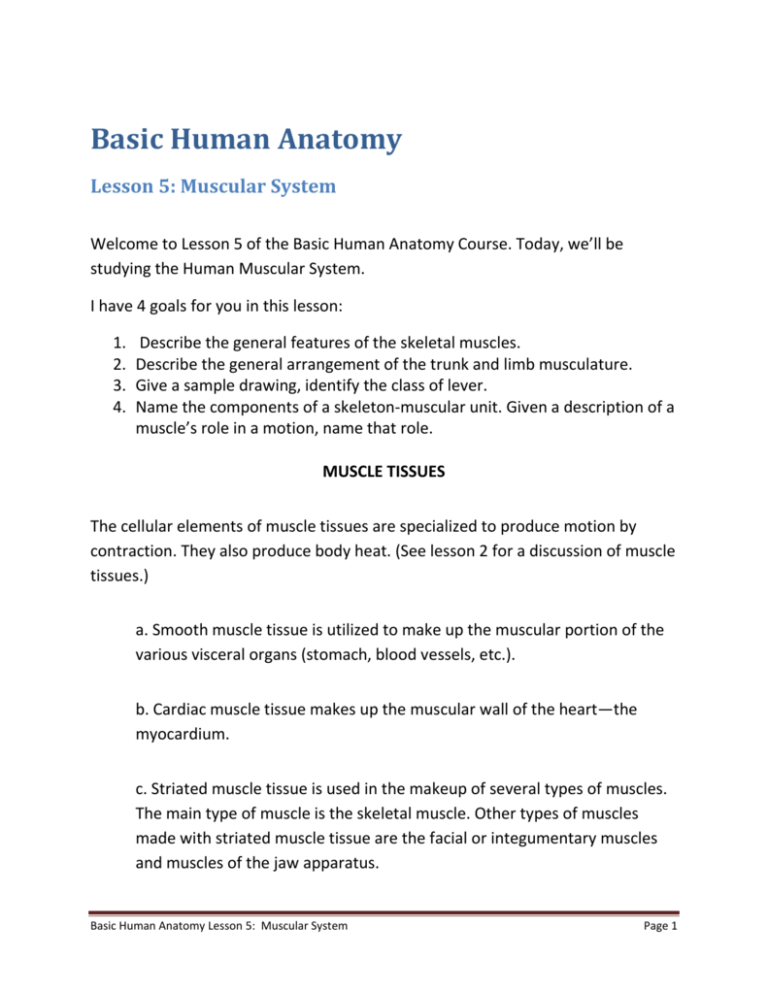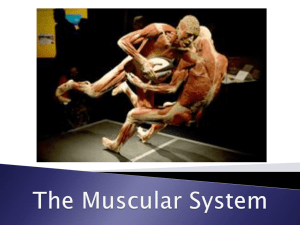
Basic Human Anatomy
Lesson 5: Muscular System
Welcome to Lesson 5 of the Basic Human Anatomy Course. Today, we’ll be
studying the Human Muscular System.
I have 4 goals for you in this lesson:
1.
2.
3.
4.
Describe the general features of the skeletal muscles.
Describe the general arrangement of the trunk and limb musculature.
Give a sample drawing, identify the class of lever.
Name the components of a skeleton-muscular unit. Given a description of a
muscle’s role in a motion, name that role.
MUSCLE TISSUES
The cellular elements of muscle tissues are specialized to produce motion by
contraction. They also produce body heat. (See lesson 2 for a discussion of muscle
tissues.)
a. Smooth muscle tissue is utilized to make up the muscular portion of the
various visceral organs (stomach, blood vessels, etc.).
b. Cardiac muscle tissue makes up the muscular wall of the heart—the
myocardium.
c. Striated muscle tissue is used in the makeup of several types of muscles.
The main type of muscle is the skeletal muscle. Other types of muscles
made with striated muscle tissue are the facial or integumentary muscles
and muscles of the jaw apparatus.
Basic Human Anatomy Lesson 5: Muscular System
Page 1
THE SKELETAL MUSCLE
Each skeletal muscle is an individual organ of the human body. Each is made up of
several types of tissues--mainly, striated muscle fibers and FCT (fibrous
connective tissue). Each is attached to and moves bones. Bones are parts of the
skeleton serving as levers.
a. General Construction of a Skeletal Muscle. The large portion of a muscle is
known as its belly or fleshy belly. This muscle is attached to bones by tendons or
aponeuroses. Tendons and aponeuroses are similar to each other. However,
tendons are cord-like and aponeuroses are broad and flat. The fleshy portion may
be directly connected to the bone. If so, it is called a "fleshy attachment."
b. Muscular NAVL (Nerves, Arteries, Veins, Lymphatics).
(1) From the main NAVL (nerve, artery, vein, lymphatic), there are branches
going to each muscle. These muscular branches are bound together by an
FCT sheath to form a neurovascular bundle.
(2) The motor point is that specific location on the surface of the muscle
where the neurovascular bundle enters.
(3) A motor unit is the single motor neuron and the number of striated
muscle fibers activated by it (innervation). The importance of the motor
unit is that its fibers work in unison. Either all fibers within a unit contract
or none contract. When a certain amount of force is needed, one unit after
another is recruited until just enough units are available to produce the
desired action.
Basic Human Anatomy Lesson 5: Muscular System
Page 2
NAMING SKELETAL MUSCLES
The name of a muscle may appear with the abbreviation M., meaning Musculus
or muscle. We abbreviate muscles (plural) with the symbol Mm. Skeletal muscles
are named according to their physical attributes (shape, size, length, etc.), their
location, or their function. For example:
SHAPE
deltoid M. (DELTA = D , Greek letter D)
biceps M. (BICEPS = two-head, BI = two CEPS = head)
SIZE
adductor magnus M. (MAGNUS = great, large)
LENGTH
adductor longus M. (LONGUS = long)
LOCATION
biceps brachii M. (BRACHII = of the arm)
biceps femoris M. (FEMORIS = of the thigh)
FUNCTION
rotatores Mm. (ROTATORES = rotators)
(They turn/rotate the vertebral column.)
ARRANGEMENT OF HUMAN SKELETAL MUSCLES
See figures 5-1 and 5-2 for some of the skeletal muscles.
Basic Human Anatomy Lesson 5: Muscular System
Page 3
Figure 5-1. Skeletal and facial muscles, anterior view.
Basic Human Anatomy Lesson 5: Muscular System
Page 4
Figure 5-2. Skeletal and facial muscles, posterior view.
Basic Human Anatomy Lesson 5: Muscular System
Page 5
a. Trunk Musculature. The trunk musculature is arranged in two ways-longitudinal muscles and oblique muscles. Together, they:
(1) Maintain trunk posture.
(2) Move the parts of the trunk.
(3) Adjust the internal pressures of the trunk to perform certain functions
such as breathing.
b. Limb Musculature. The limb musculature is arranged around the joints to
produce the appropriate motions of the limbs. Elementary mechanics are
described in the next section to help you to understand typical arrangements of
limb musculature.
SOME ELEMENTARY SKELETO-MUSCULAR MECHANICS
GENERAL
Muscles and bones together work like machines within the laws of physics and
chemistry. Lever and pulley systems are examples of simple machines found
commonly in the human body.
LEVER SYSTEMS
See figure 5-3 for an illustration of the three classes of levers.
a. First Class. In a first class lever, the weight to be moved is at one end of the
lever, the applied force is at the other end, and the fulcrum (the pivot or turning
point) is between the two.
Basic Human Anatomy Lesson 5: Muscular System
Page 6
b. Second Class. In a second class lever, the weight to be moved is between the
applied force and the fulcrum. This type of lever enables a weight to be moved
with less force than would be required without a lever. (Many feel that there are
no second class levers in the human body.)
c. Third Class. In a third class lever, the weight to be moved is at one end of the
lever, the fulcrum is at the other end, and the applied force is between the weight
and the fulcrum. This type of lever provides speed, but a greater amount of force
is required for a given weight. This is the most common type of lever in the
human body.
Figure 5-3. Types of lever systems.
Basic Human Anatomy Lesson 5: Muscular System
Page 7
SIMPLE PULLEY SYSTEM
a. In the human body when the tendon of a skeletal muscle slides over a round
bony surface, the "system" acts like a simple pulley (figure 5-4). A simple pulley
provides a change in the direction of the force or muscle pull. There is no change
in the amount of force produced by the muscle. For example, the knee acts as a
simple pulley by which the quadriceps femoris M. extends the leg.
Figure 5-4. A simple pulley (the human knee mechanism).
b. Sesamoid bones, such as the patella (kneecap), develop in tendons where
pressure is applied to the tendon.
Basic Human Anatomy Lesson 5: Muscular System
Page 8
THE SKELETO-MUSCULAR UNIT
The skeleto-muscular unit (figure 5-5) is a working concept of muscle and skeleton
producing motion. The components of an S-M unit are bones, a joint, and skeletal
muscle(s).
Figure 5-5. The skeleto-muscular unit (arm-forearm flexion)
(3rd class lever system)).
a. Bones. Bones act as levers and as attachment sites for skeletal muscles.
b. Joint (Articulation). The joint is the center, fulcrum, point, or axis of motion.
Basic Human Anatomy Lesson 5: Muscular System
Page 9
c. Skeletal Muscle(s). Skeletal muscles apply the forces for motion. Any given
motion utilizes a group of muscles working together. A skeletal muscle may serve
only one of the three following major roles during a particular motion:
(1) Prime mover. The muscle which makes the main effort for a given
motion is called the prime mover, or agonist.
(2) Synergist. A synergist is a muscle which assists the prime mover.
SYN = together
ERG = unit of effort
(3) Antagonist. An antagonist applies a force opposite to that of the prime
mover.
(a) By opposing the prime mover, the antagonist helps control the
motion.
(b) The antagonist also brings the limb or other part back to its
original position.
Introduction to Basic Human Anatomy is a distance learning product that is based on the
Correspondence Subcourse MD0006 of the U.S. Army Medical Department Center and School.
This presentation was produced by the Brookside Associates, Ltd., which is privately-held and
not connected to any governmental agency. The views expressed here are those of the authors,
and unless otherwise noted, do not necessarily reflect the views of the Brookside Associates,
Ltd., any governmental agencies or private organizations. This presentation is unclassified, and
© 2009, with all rights reserved.
Basic Human Anatomy Lesson 5: Muscular System
Page 10










